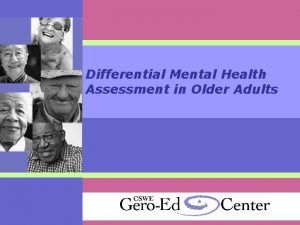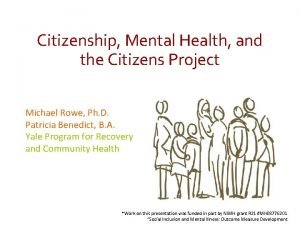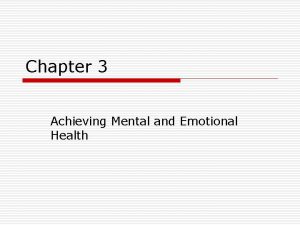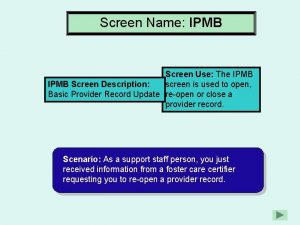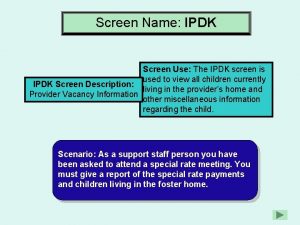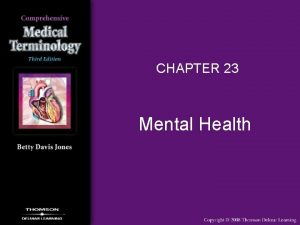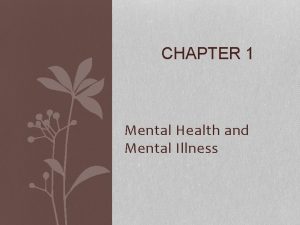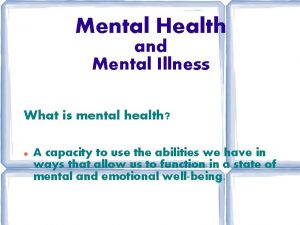Girls Health Screen Genderresponsive Health and Mental Health




















- Slides: 20

Girls Health Screen Gender-responsive Health and Mental Health Services for Girls in PYJI Planning Sites Sierra Health Foundation Positive Youth Justice Initiative June 19, 2013 Copyright © 2013 Leslie Acoca

Pregnancy Behind Bars Pregnancy is among the most common issues; about a third of girls entering juvenile facilities nationwide have been pregnant in the past month. "I would cry out of nowhere, " says a 17 year-old incarcerated girl, who is pregnant and already has another child. This young woman was raised by her parents’ drug counselor, and suffers from asthma, ADHD, depression, and drug use. She didn't see a therapist until she got locked up. -- from Los Angeles Times, Anna Gorman, March 17, 2013 Copyright © 2013 Leslie Acoca

Trauma and Girls “I was raped. Now the people in here know I’ve had girlfriends, so I have to sleep alone in a six-by-six cell and shower alone. I feel hopeless. ” -- 12 year-old girl in a New Mexico detention center (Acoca, NPR’s All Things Considered radio interview, 2012) “Incarcerated girls are one of the most vulnerable and unfortunately invisible populations in the country, and up to 90 percent have experienced physical, sexual, or emotional abuse. ” -- Catherine Pierce, OJJDP (Jenny Gold, Kaiser Health News, 2012) Copyright © 2013 Leslie Acoca

What is the Nat’l Girls Health and Justice Institute? The National Girls Health and Justice Institute (NGHJI) is dedicated to ensuring that every girl in the Juvenile Justice System receives health screening, assessment and treatment, and is linked to medical homes in communities We developed the Girls Health Screen and Girls Health Passport to identify, treat and follow girls’ health and mental health needs Our mission is to improve the health of adolescent girls in the Juvenile Justice System and that of their children and families Copyright © 2013 Leslie Acoca

Who developed the Girls Health Screen (GHS)? National Girls Health and Justice Institute Juvenile Law Center Children’s Hospital of Philadelphia (CHOP) San Diego and Santa Cruz, California; Philadelphia, Pennsylvania; and the Albuquerque, New Mexico Juvenile Justice Systems Copyright © 2013 Leslie Acoca

Why we created the GHS Girls are the fastest growing segment of the Juvenile Justice System. Girls are arrested younger and for less serious offenses than boys – like running away – and are more likely to have been in foster care Girls have unique and often more serious physical and mental health needs including reproductive, STIs, HIV/AIDS, and sexual violence Medical standards are inadequate or non-existent, and vary significantly in intake services Dearth of current data on physical and behavioral health of detained girls Lack of continuity between residential health services for girls and medical homes in communities Copyright © 2013 Leslie Acoca

Physical Health Care Reduces Girls’ Offending Findings from Educate or Incarcerate: Girls in the Florida and Duval County Juvenile Justice System, a study including over 900 girls in the Juvenile Justice System. (Acoca, 2001) Girls receiving physical health care were 72% less likely to re-offend or commit violent offenses Girls receiving mental health care 37% less likely to re-offend or commit violent offenses Copyright © 2013 Leslie Acoca

Lack of Medical Standards in Juvenile Detention Centers Only 53 of 3, 500 Juvenile Justice residential facilities in the U. S. accredited No systematic medical screening or assessment, no evidence based screening/assessments for girls Only 18% of facilities regularly gave girls pregnancy tests Source: (Gallager and Dobrin, 2007) Copyright © 2013 Leslie Acoca

What is the Girls Health Screen? First validated, gender-responsive physical and mental health screen for detained girls 11 -17 years old in the nation Triage model questionnaire including Urgent, Care and Advocacy components Self-report instrument designed for 4 th grade comprehension with yes/no answers Available in paper/pencil and i. Pad Application formats with audio function. The questions appear on a screen and can be heard via the i. Pad audio function in English and Spanish. Copyright © 2013 Leslie Acoca

Girls Health Screen i. Pad “App” Copyright © 2013 Leslie Acoca

Girls Health/Reproductive Problems (GHS Study, 2013) 41% and 24% respectively had abnormal vaginal or rectal examinations possibly due to sexual assault 22% reported a history of forced sexual contact, and several reported assault within the past 7 days 20% had been pregnant at least once; only 12% had medical care during pregnancy 11% of girls with pregnancy history had miscarried Copyright © 2013 Leslie Acoca

Core elements: Gender- Responsive programming Responsive to the unique trauma-related experiences of girls individually and with their families. Providing intensive and often long-term substance abuse treatment Evidence-based, gender responsive screening, assessment and treatment Services go beyond “gender-neutral” to genderspecific to identify and address the specific needs of girls and their children and families

Core Principals of Gender- Responsive Services Respectful relationships with peers, providers and family Safe environment with concrete needs for food, shelter, transportation and health care provided for Girl- specific living environment, not shared with boys Inclusive of educational, vocational and job readiness Inclusive of healthy self-care and linkage with medical home in the community for girls and

Where is the Girls Health Screen implemented & by whom? Los Angeles County, CA Los Angeles County Department of Probation, 112 girls in Probation Camp Scudder, expanding to Detention and other Probation facilities holding girls A collaboration of Los Angeles County Departments of Health and Mental Health Services and Probation, and the National Girls Health and Justice Institute GHS in Los Angeles identifies and helps address the pregnancy and family planning needs of girls Copyright © 2013 Leslie Acoca

Where/how could the GHS be implemented for “crossover” girls? Girls in the Juvenile Justice System are proportionately more likely to have prior histories of foster care 26% of detained girls had foster care histories or lived outside of home (GHS Study, 2013) Multiple jurisdictions and States evaluating the GHS for both their Juvenile Justice and Child Welfare Systems to identify and address girls’ health needs Copyright © 2013 Leslie Acoca

GHS Pilot Project in New Mexico (Featured on NPR and Kaiser Health News, Nov. 2012) Girls Health Screen administered to 30 girls entering the Albuquerque Detention Center in January, 2012 25 reported acute medical problems requiring medical attention within one hour Acute problems girls reported: vaginal discharge, blisters, and warts; feeling hopeless, recent physical injury or sexual assault Copyright © 2013 Leslie Acoca

How the GHS works in Juvenile Justice and Foster Care Step One: GHS adopted as standard intake procedure for girls entering detention or foster care Step Two: GHS results used to trigger acute medical responses for girls entering detention and foster care Step Three: GHS used to guide medical assessment and treatment planning Step Four: GHS used to guide pre-release planning and link girls to medical homes in communities Copyright © 2013 Leslie Acoca

Next Steps (2013 -2015) Develop a secure web platform/database to make GHS accessible at intake to girls in detention Pilot the web-based GHS in Los Angeles, California, the State of New Mexico, and nationally Initiate an electronic Girls Health Passport continuum of medical screening, assessment, treatment and follow-up Copyright © 2013 Leslie Acoca

GHS Assistance and Expansion Working with six California Counties to introduce the Girls Health Screen and gender-responsive health and reproductive services for crossover girls Alameda County Sacramento County Solano County San Diego County San Joaquin County Yolo County Copyright © 2013 Leslie Acoca

Questions and Comments Copyright © 2013 Leslie Acoca
 Screen small screen offscreen
Screen small screen offscreen Mental health and mental illness chapter 20
Mental health and mental illness chapter 20 Mental health jeopardy questions
Mental health jeopardy questions Ladies and gentlemen, boys and girls
Ladies and gentlemen, boys and girls Reportive definition
Reportive definition Good morning, boys
Good morning, boys Good morning, boys
Good morning, boys Cite one example in your school or community of teenagers
Cite one example in your school or community of teenagers Boys and girls short story
Boys and girls short story Shakopee girls swim and dive
Shakopee girls swim and dive My name is
My name is Slidetodoc.com
Slidetodoc.com Dear boys and girls
Dear boys and girls Boys and girls learn differently
Boys and girls learn differently Boys and girls brains
Boys and girls brains Chapter 3 lesson 3 expressing emotions in healthful ways
Chapter 3 lesson 3 expressing emotions in healthful ways Mental health and older adults
Mental health and older adults Law enforcement mental health and wellness act
Law enforcement mental health and wellness act Mental health and older adults
Mental health and older adults Mental health and citizenship
Mental health and citizenship Chapter 3 achieving mental and emotional health
Chapter 3 achieving mental and emotional health


















